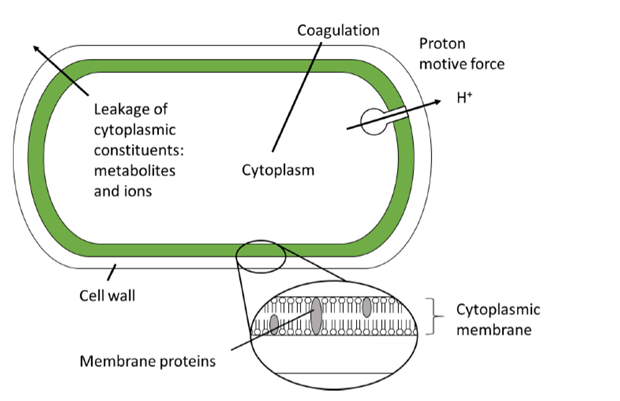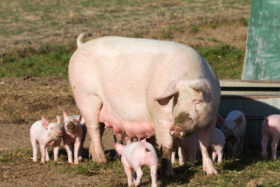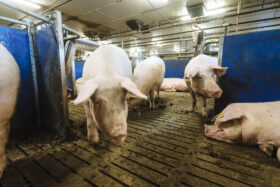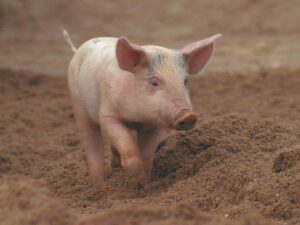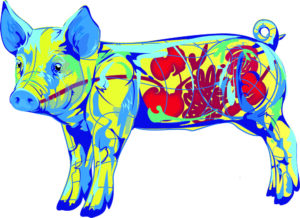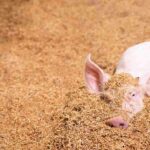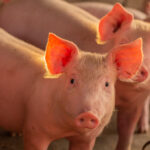By Dr. Inge Heinzl, Editor, EW Nutrition
In June 2017, the European Commission decided to ban the use of veterinary drugs containing high doses of zinc oxide (3000mg/kg) from 2022. The use of zinc oxide in pig production must then be limited to a maximum level of 150ppm. Companies have been on the lookout for effective alternative strategies to maintain high profitability.
Modern pig production is characterised by its high intensity. In many European countries, piglets are weaned after 3-4 weeks, before their physiological systems are fully developed (e.g. immune and enzyme system). Weaning and thus separation from the mother, as well as a new environment with new germs, means stress for the piglets. Besides, the highly digestible sow’s milk, for which the piglets are wholly adapted, is replaced by solid starter feed.
This, associated with the above-mentioned stressors, can result in reduced feed intake during the first week after weaning and therefore in a delayed adaptation of the intestinal flora to the feed. Since the immune system of animals is not yet fully functional, pathogens such as enterotoxic E. coli can colonize the intestinal mucosa. This can possibly develop into a dangerous dysbiosis, leading to an increased incidence of diarrhea. Inadequate absorption results in suboptimal growth with worse feed conversion. The consequences are economic losses due to higher treatment costs, lower yields, and animal losses.
Diarrhea is one of the most common causes of economic losses in pig production. In the past, this was the reason antibiotics were prophylactically used as growth promoters. Antibiotics reduce antimicrobial pressure and have an anti-inflammatory effect. In addition to reducing the incidence of disease, they eliminate competitors for nutrients in the gut and thus improve feed conversion.
However, the use of antibiotics as growth promoters has been banned in the EU since 2006 due to increased antimicrobial resistance. As a result, zinc oxide (ZnO) appeared on the scene. A study carried out in Spain in 2012 (Moreno, 2012) showed that 57% of piglets received ZnO before weaning and 73% during the growth phase (27-75 days).
Zinc oxide: the disadvantages outweigh the advantages
What made the use of zinc oxide so attractive? Zinc oxide is inexpensive, available in many EU countries, and as a trace element it can be used in high doses through premixing. In some countries, however, a veterinary prescription is needed; in others, the use is already banned.
Zinc is a trace element involved in cell division and differentiation, and it influences the efficacy of enzymes. Since defence cells also need zinc, a supplementation that covers the demand for zinc strengthens the body’s defences. Through a positive effect on the structure of the gut mucosa membrane, zinc protects the body against the penetration of pathogenic germs.
If ZnO is used in pharmacological doses, it has a bactericidal effect against e.g. staphylococci (Ann et al., 2014) and various types of E. coli (Vahjen et al., 2016). Thus, prophylactic use prevents the incidence of diarrhea and the consequent decrease in performance. But the use of zinc oxide also has “side effects”.
Accumulation in the environment
Zinc belongs to the chemical group of heavy metals. For the use as a performance enhancer, it has to be administered in relatively high doses (2000–4000ppm). These high amounts are far above the physiological needs of the animals. With relatively low absorption rates (the bioavailability amounts to approximately 20% (European Commission, 2003)) and subsequent accumulation in manure, zinc can cause substantial contamination of the environment.
Encouraging the development of antibiotic resistance
In addition to the accumulation of zinc in the environment, another aspect also plays an important role: according to Vahjen et al. (2015), a dose of ≥2500mg/kg of food increases the presence of tetracycline and sulfonamide resistance genes in bacteria. In the case of Staphylococcus aureus, the development of resistance to zinc is combined with the development of resistance to methicillin (MRSA; Cavaco et al., 2011; Slifierz et al., 2015). A similar effect can be observed in the development of multiresistant E. coli (Bednorz et al., 2013; Ciesinski et al., 2018). The reason for this is that the genes that encode antibiotic resistance, i.e. the ones that are “responsible” for the resistance, are found in the same plasmid (a DNA molecule that is small and independent of the bacterial chromosome).
Consequence: no more zinc oxide in the production of piglets from 2022 onwards
The negative effects on the environment and the promotion of antibiotic resistance led to the European Commission’s decision in 2017 to completely ban zinc oxide as a therapeutic agent and as a growth promoter in piglets within five years.
There are effective alternatives to zinc oxide
By the 2022 deadline, the EU pig industry must find a solution to replace ZnO. It must develop strategies that make future pig production efficient, even without substances such as antibiotics and zinc oxide. To this end, measures should be taken at different levels, such as farm management and biosecurity (e.g. effective hygiene management). The promotion of intestinal health for high animal performance is most important, however.
Promotion of gut health through stable gut microbiota
The term eubiosis denotes the balance of microorganisms living in a healthy intestine, which must be maintained to prevent diarrhea and ensure performance. However, weaning, food switching, and other external stressors can endanger this balance. As a result, potentially pathogenic germs can “overgrow” the commensal microbiome and develop dysbiosis. Through the use of functional supplements, intestinal health can be improved.
Phytomolecules – potent compounds created by nature
Phytomolecules, or secondary plant compounds, are substances formed by plants with a wide variety of properties. The best-known groups are probably essential oils, but there are also bitter substances, spicy substances, and other groups.
In animal nutrition, phytomolecules such as carvacrol, cinnamon aldehyde, and capsaicin can help improve intestinal health and digestion. They stabilize the intestinal flora by slowing or stopping the growth of pathogens that can cause disease. How? Phytomolecules, for example, make the cell walls of several bacteria permeable so that cell contents can leak. They also partially interfere with the enzymatic metabolism of the cell or intervene with the transport of ions, reducing the proton motive force. These effects depend on the dose: all these actions can destroy bacteria or at least prevent their proliferation.
Another point of attack for phytomolecules is the communication between microorganisms (quorum sensing). Phytomolecules can prevent microorganisms from releasing substances known as autoinducers, which they need to coordinate joint actions such as the formation of biofilms or the expression of virulence factors.
Medium-chain triglycerides and fatty acids
Medium-chain triglycerides (MCT) and fatty acids (MCFA) are characterised by a length of six to twelve carbon atoms. Thanks to their efficient absorption and metabolism, they can be optimally used as an energy source in piglet feeding. MCTs can be completely absorbed by the epithelial cells of the intestinal mucosa and hydrolysed with microsomal lipases. Hence they serve as an immediately available energy source and can improve the epithelial structure of the intestinal mucosa (Hanczakowska, 2017).
In addition, these supplements have a positive influence on the composition of the intestinal flora. Their ability to penetrate bacteria through semi-permeable membranes and destroy bacterial structures inhibits the development of pathogens such as salmonella and coliforms (Boyen et al., 2008; Hanczakowska, 2017; Zentek et al., 2011). MCFAs and MCTs can also be used very effectively against gram-positive bacteria such as streptococci, staphylococci, and clostridia (Shilling et al., 2013; Zentek et al., 2011).
Prebiotics
Prebiotics are short-chain carbohydrates that are indigestible for the host animal. However, certain beneficial microorganisms such as lactobacilli and bifidobacteria can use these substances as substrates. By selectively stimulating the growth of these bacteria, eubiosis is promoted (Ehrlinger, 2007). In pigs, mannan-oligosaccharides (MOS), fructooligosaccharides (FOS), inulin and lignocellulose are mainly used.
Another element of prebiotics’ positive effect on intestinal health is their ability to agglutinate pathogens. Pathogenic bacteria and MOS can bind to each other through lectin. This agglutination prevents pathogenic bacteria from adhering to the wall of the intestinal mucosa and thus from colonizing the intestine (Oyofo et al., 1989).
Probiotics
Probiotics can be used to regenerate an unbalanced gut flora. To do this, useful bacteria such as bifido or lactic acid bacteria are added to the food. They must settle in the gut and compete with the harmful bacteria.
There are also probiotics which target the communication between pathogens. In an experiment, Kim et al. (2017) found that the addition of probiotics that interfere with quorum sensing can significantly improve the microflora in weaned piglets and thus their intestinal health.
Organic acids
Organic acids show strong antibacterial activity in animals. In their undissociated form, the acids can penetrate bacteria. Inside, the acid molecule breaks down into a proton (H+) and an anion (HCOO-). The proton reduces the pH value in the bacterial cell and the anion interferes with the bacteria’s protein metabolism. As a result, bacterial growth and virulence are inhibited.
Conclusion
Today there are several possibilities in piglet nutrition to effectively support the young animals after weaning. The main objective is to maintain a balanced intestinal flora and therefore to sustain intestinal health – its deterioration often leads to diarrhea and hence to reduced returns. Intestinal health is promoted by stimulating beneficial bacteria and by inhibiting pathogenic ones. This can be achieved through feed additives that have an antibacterial effect and/or support the intestinal mucosa, such as phytomolecules, prebiotics, and medium-chain fatty acids. Through a combination of these possibilities, additive effects can be achieved. Piglets receive optimal support and the use of zinc oxide can be reduced.
References
Ann, Ling Chuo, Shahrom Mahmud, Siti Khadijah Mohd Bakhori, Amna Sirelkhatim, Dasmawati Mohamad, Habsah Hasan, Azman Seeni, and Rosliza Abdul Rahman. “Antibacterial Responses of Zinc Oxide Structures against Staphylococcus Aureus, Pseudomonas Aeruginosa and Streptococcus Pyogenes.” Ceramics International 40, no. 2 (March 2014): 2993–3001. https://doi.org/10.1016/j.ceramint.2013.10.008.
Bednorz, Carmen, Kathrin Oelgeschläger, Bianca Kinnemann, Susanne Hartmann, Konrad Neumann, Robert Pieper, Astrid Bethe, et al. “The Broader Context of Antibiotic Resistance: Zinc Feed Supplementation of Piglets Increases the Proportion of Multi-Resistant Escherichia Coli in Vivo.” International Journal of Medical Microbiology 303, no. 6-7 (August 2013): 396–403. https://doi.org/10.1016/j.ijmm.2013.06.004.
Boyen, F., F. Haesebrouck, A. Vanparys, J. Volf, M. Mahu, F. Van Immerseel, I. Rychlik, J. Dewulf, R. Ducatelle, and F. Pasmans. “Coated Fatty Acids Alter Virulence Properties of Salmonella Typhimurium and Decrease Intestinal Colonization of Pigs.” Veterinary Microbiology 132, no. 3-4 (December 10, 2008): 319–27. https://doi.org/10.1016/j.vetmic.2008.05.008.
Cavaco, Lina M., Henrik Hasman, Frank M. Aarestrup, Members Of Mrsa-Cg: Jaap A. Wagenaar, Haitske Graveland, Kees Veldman, et al. “Zinc Resistance of Staphylococcus Aureus of Animal Origin Is Strongly Associated with Methicillin Resistance.” Veterinary Microbiology 150, no. 3-4 (June 2, 2011): 344–48. https://doi.org/10.1016/j.vetmic.2011.02.014.
Ciesinski, Lisa, Sebastian Guenther, Robert Pieper, Martin Kalisch, Carmen Bednorz, and Lothar H. Wieler. “High Dietary Zinc Feeding Promotes Persistence of Multi-Resistant E. Coli in the Swine Gut.” Plos One 13, no. 1 (January 26, 2018). https://doi.org/10.1371/journal.pone.0191660.
Crespo-Piazuelo, Daniel, Jordi Estellé, Manuel Revilla, Lourdes Criado-Mesas, Yuliaxis Ramayo-Caldas, Cristina Óvilo, Ana I. Fernández, Maria Ballester, and Josep M. Folch. “Characterization of Bacterial Microbiota Compositions along the Intestinal Tract in Pigs and Their Interactions and Functions.” Scientific Reports 8, no. 1 (August 24, 2018). https://doi.org/10.1038/s41598-018-30932-6.
Ehrlinger, Miriam. 2007. “Phytogene Zusatzstoffe in der Tierernährung.“ PhD Diss., LMU München. URN: urn:nbn:de:bvb:19-68242.
European Commission. 2003. “Opinion of the Scientific Committee for Animal Nutrition on the use of zinc in feedingstuffs.” https://ec.europa.eu/food/sites/food/files/safety/docs/animal-feed_additives_rules_scan-old_report_out120.pdf
Hanczakowska, Ewa. ”The use of medium chain fatty acids in piglet feeding – a review.” Annals of Animal Science 17, no. 4 (October 27, 2017): 967-977. https://doi.org/10.1515/aoas-2016-0099.
Hansche, Bianca Franziska. 2014. „Untersuchung der Effekte von Enterococcus faecium (probiotischer Stamm NCIMB 10415) und Zink auf die angeborene Immunantwort im Schwein. Dr. rer. Nat. Diss., Freie Universität Berlin. https://doi.org/10.17169/refubium-8548
Kim, Jonggun, Jaepil Kim, Younghoon Kim, Sangnam Oh, Minho Song, Jee Hwan Choe, Kwang-Youn Whang, Kwang Hyun Kim, and Sejong Oh. “Influences of Quorum-Quenching Probiotic Bacteria on the Gut Microbial Community and Immune Function in Weaning Pigs.” Animal Science Journal 89, no. 2 (November 20, 2017): 412–22. https://doi.org/10.1111/asj.12954.
Oyofo, Buhari A., John R. Deloach, Donald E. Corrier, James O. Norman, Richard L. Ziprin, and Hilton H. Mollenhauer. “Effect of Carbohydrates on Salmonella Typhimurium Colonization in Broiler Chickens.” Avian Diseases 33, no. 3 (1989): 531–34. https://doi.org/10.2307/1591117.
Shilling, Michael, Laurie Matt, Evelyn Rubin, Mark Paul Visitacion, Nairmeen A. Haller, Scott F. Grey, and Christopher J. Woolverton. “Antimicrobial Effects of Virgin Coconut Oil and Its Medium-Chain Fatty Acids On Clostridium Difficile.” Journal of Medicinal Food 16, no. 12 (December 2013): 1079–85. https://doi.org/10.1089/jmf.2012.0303.
Slifierz, M. J., R. Friendship, and J. S. Weese. “Zinc Oxide Therapy Increases Prevalence and Persistence of Methicillin-Resistant Staphylococcus Aureus in Pigs: A Randomized Controlled Trial.” Zoonoses and Public Health 62, no. 4 (September 11, 2014): 301–8. https://doi.org/10.1111/zph.12150.
Vahjen, Wilfried, Dominika Pietruszyńska, Ingo C. Starke, and Jürgen Zentek. “High dietary zinc supplementation increases the occurrence of tetracycline and sulfonamide resistance genes in the intestine of weaned pigs.” Gut Pathogens 7, article number 23 (August 26, 2015). https://doi.org/10.1186/s13099-015-0071-3.
Vahjen, Wilfried, Agathe Roméo, and Jürgen Zentek. “Impact of zinc oxide on the immediate postweaning colonization of enterobacteria in pigs.” Journal of Animal Science 94, supplement 3 (September 1, 2016): 359-363. https://doi.org/10.2527/jas.2015-9795.
Zentek, J., S. Buchheit-Renko, F. Ferrara, W. Vahjen, A.G. Van Kessel, and R. Pieper. “Nutritional and physiological role of medium-chain triglycerides and medium-chain fatty acids in piglets” Animal Health Research Reviews 12, no. 1 (June 2011): 83-93. https://doi.org/10.1017/s1466252311000089.
